Critical Appraisal of Evidence-Based Practice and Published Literature
VerifiedAdded on 2023/06/11
|8
|1947
|314
AI Summary
This paper presents a critical analysis of the concept of Evidence-Based Practice in reference to published literature. It also discusses the individual and organizational barriers that hinder the implementation of EBP.
Contribute Materials
Your contribution can guide someone’s learning journey. Share your
documents today.
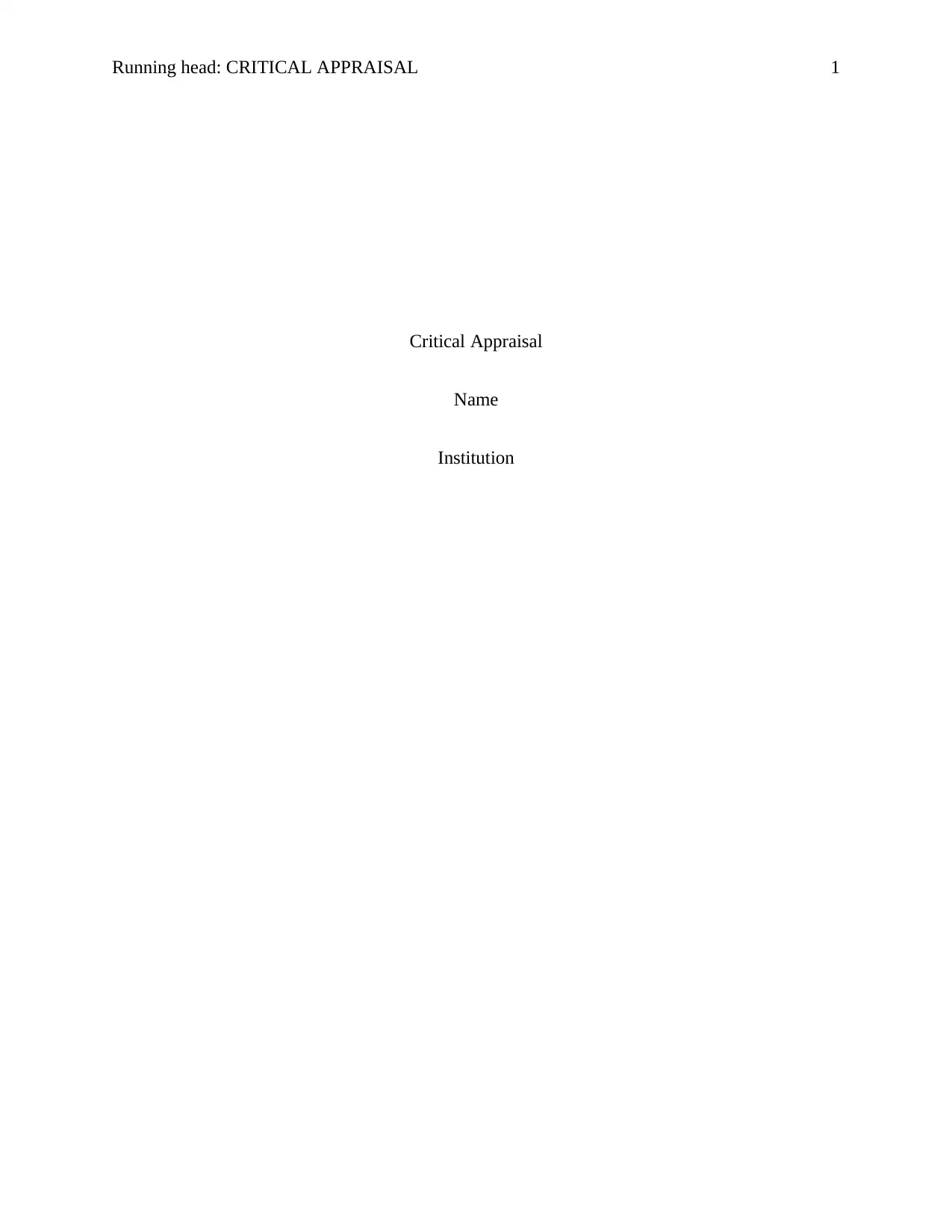
Running head: CRITICAL APPRAISAL 1
Critical Appraisal
Name
Institution
Critical Appraisal
Name
Institution
Secure Best Marks with AI Grader
Need help grading? Try our AI Grader for instant feedback on your assignments.

CRITICAL APPRAISAL 2
Critical Appraisal
Introduction
Nursing is a challenging and dynamic discipline that requires a practitioner to be
knowledgeable and all-round. A competent nurse should possess a wide range of attributes such
as effective interpersonal communication, intercultural understanding, decision-making,
educational, and problem-solving skills. That is the only way through which a nurse can deliver
quality healthcare services to the satisfaction of the patients. However, to acquire, develop,
nurture, and refine such skills, a nurse should be ready to embrace the culture of Evidence-Based
Practice because it emphasizes on the need of integrating personal knowledge with external
clinical evidence from scientific research. The purpose of this paper is to present a critical
analysis of the concept of Evidence-Based Practice in reference to published literature.
Part A
"Exploring Resilience and Mindfulness as Preventative Factors for Psychological Distress
Burnout and Secondary Traumatic Stress among Human Service Professionals"
I would like to begin this task by conducting a critical appraisal of "Exploring Resilience
and Mindfulness as Preventative Factors for Psychological Distress Burnout and Secondary
Traumatic Stress among Human Service Professionals." This is an article that was authored by
Frances Klaassen, Harker, Rachel, Steven King, and Aileen M. Pidgeon. The authors use this
article to provide a comprehensive analysis of the correlation between the concepts of Secondary
Traumatic Stress, psychological burn out, and distress on one hand and resilience and
mindfulness on the other hand. In accordance to their findings, the researchers establish that
psychological burn out, distress and Secondary Traumatic Stress are common challenges faced
Critical Appraisal
Introduction
Nursing is a challenging and dynamic discipline that requires a practitioner to be
knowledgeable and all-round. A competent nurse should possess a wide range of attributes such
as effective interpersonal communication, intercultural understanding, decision-making,
educational, and problem-solving skills. That is the only way through which a nurse can deliver
quality healthcare services to the satisfaction of the patients. However, to acquire, develop,
nurture, and refine such skills, a nurse should be ready to embrace the culture of Evidence-Based
Practice because it emphasizes on the need of integrating personal knowledge with external
clinical evidence from scientific research. The purpose of this paper is to present a critical
analysis of the concept of Evidence-Based Practice in reference to published literature.
Part A
"Exploring Resilience and Mindfulness as Preventative Factors for Psychological Distress
Burnout and Secondary Traumatic Stress among Human Service Professionals"
I would like to begin this task by conducting a critical appraisal of "Exploring Resilience
and Mindfulness as Preventative Factors for Psychological Distress Burnout and Secondary
Traumatic Stress among Human Service Professionals." This is an article that was authored by
Frances Klaassen, Harker, Rachel, Steven King, and Aileen M. Pidgeon. The authors use this
article to provide a comprehensive analysis of the correlation between the concepts of Secondary
Traumatic Stress, psychological burn out, and distress on one hand and resilience and
mindfulness on the other hand. In accordance to their findings, the researchers establish that
psychological burn out, distress and Secondary Traumatic Stress are common challenges faced
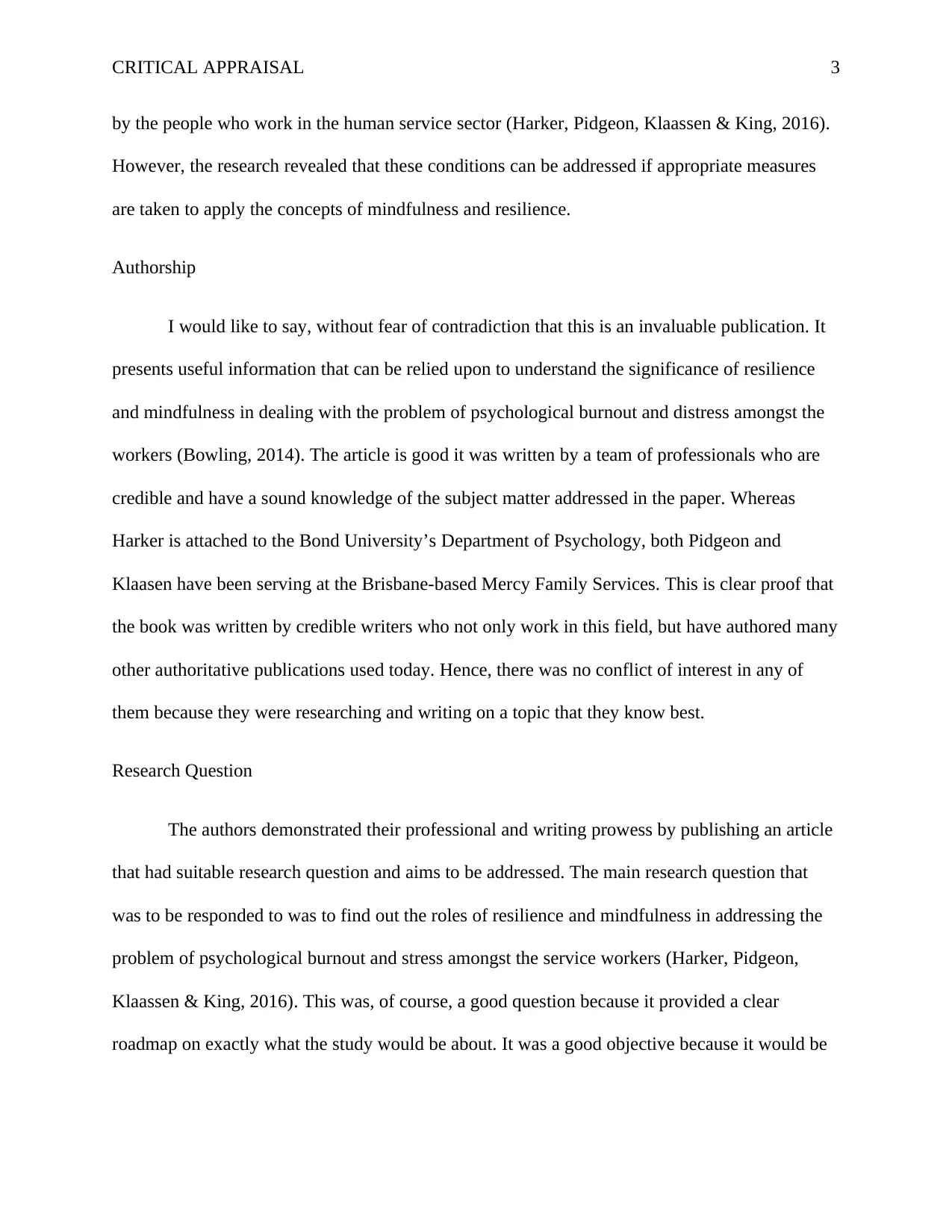
CRITICAL APPRAISAL 3
by the people who work in the human service sector (Harker, Pidgeon, Klaassen & King, 2016).
However, the research revealed that these conditions can be addressed if appropriate measures
are taken to apply the concepts of mindfulness and resilience.
Authorship
I would like to say, without fear of contradiction that this is an invaluable publication. It
presents useful information that can be relied upon to understand the significance of resilience
and mindfulness in dealing with the problem of psychological burnout and distress amongst the
workers (Bowling, 2014). The article is good it was written by a team of professionals who are
credible and have a sound knowledge of the subject matter addressed in the paper. Whereas
Harker is attached to the Bond University’s Department of Psychology, both Pidgeon and
Klaasen have been serving at the Brisbane-based Mercy Family Services. This is clear proof that
the book was written by credible writers who not only work in this field, but have authored many
other authoritative publications used today. Hence, there was no conflict of interest in any of
them because they were researching and writing on a topic that they know best.
Research Question
The authors demonstrated their professional and writing prowess by publishing an article
that had suitable research question and aims to be addressed. The main research question that
was to be responded to was to find out the roles of resilience and mindfulness in addressing the
problem of psychological burnout and stress amongst the service workers (Harker, Pidgeon,
Klaassen & King, 2016). This was, of course, a good question because it provided a clear
roadmap on exactly what the study would be about. It was a good objective because it would be
by the people who work in the human service sector (Harker, Pidgeon, Klaassen & King, 2016).
However, the research revealed that these conditions can be addressed if appropriate measures
are taken to apply the concepts of mindfulness and resilience.
Authorship
I would like to say, without fear of contradiction that this is an invaluable publication. It
presents useful information that can be relied upon to understand the significance of resilience
and mindfulness in dealing with the problem of psychological burnout and distress amongst the
workers (Bowling, 2014). The article is good it was written by a team of professionals who are
credible and have a sound knowledge of the subject matter addressed in the paper. Whereas
Harker is attached to the Bond University’s Department of Psychology, both Pidgeon and
Klaasen have been serving at the Brisbane-based Mercy Family Services. This is clear proof that
the book was written by credible writers who not only work in this field, but have authored many
other authoritative publications used today. Hence, there was no conflict of interest in any of
them because they were researching and writing on a topic that they know best.
Research Question
The authors demonstrated their professional and writing prowess by publishing an article
that had suitable research question and aims to be addressed. The main research question that
was to be responded to was to find out the roles of resilience and mindfulness in addressing the
problem of psychological burnout and stress amongst the service workers (Harker, Pidgeon,
Klaassen & King, 2016). This was, of course, a good question because it provided a clear
roadmap on exactly what the study would be about. It was a good objective because it would be
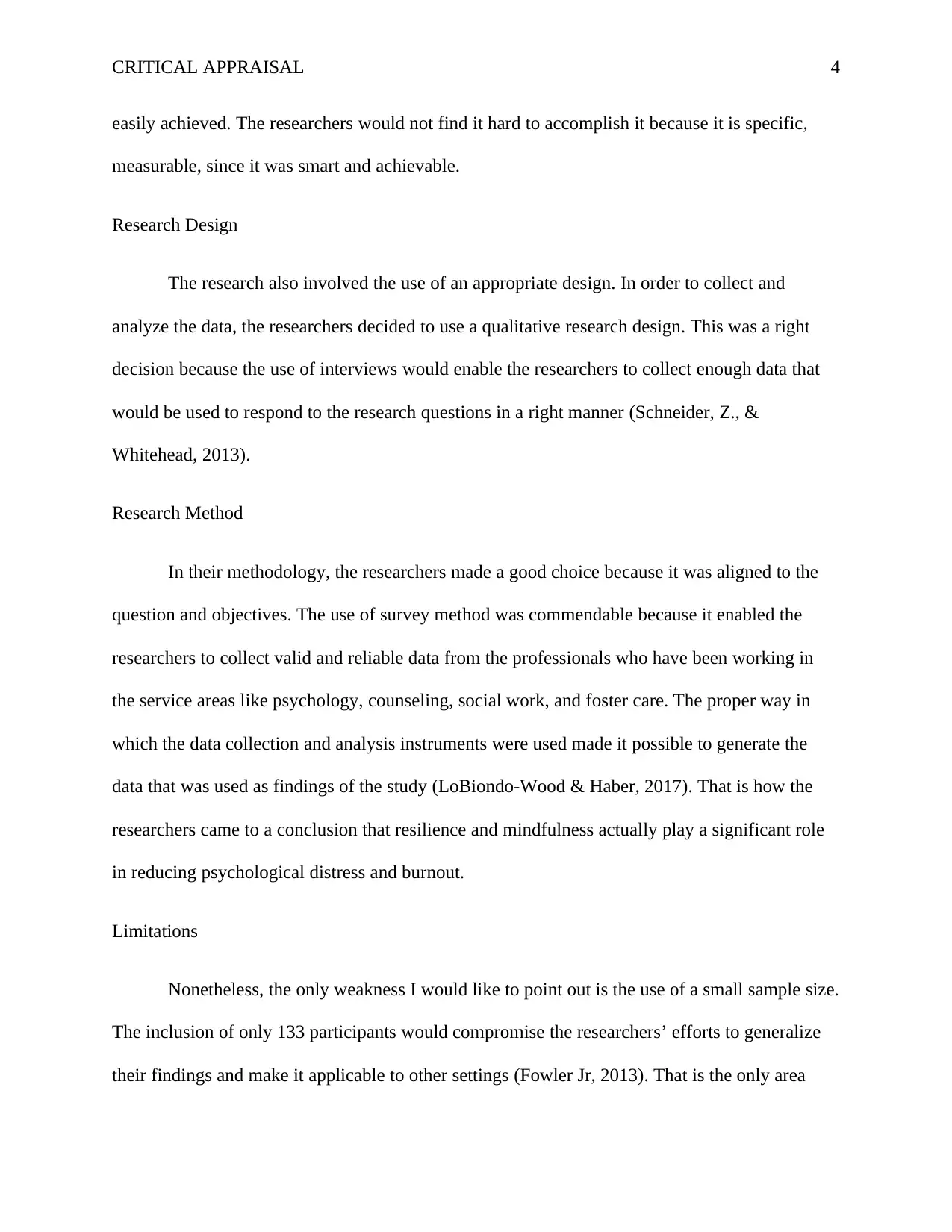
CRITICAL APPRAISAL 4
easily achieved. The researchers would not find it hard to accomplish it because it is specific,
measurable, since it was smart and achievable.
Research Design
The research also involved the use of an appropriate design. In order to collect and
analyze the data, the researchers decided to use a qualitative research design. This was a right
decision because the use of interviews would enable the researchers to collect enough data that
would be used to respond to the research questions in a right manner (Schneider, Z., &
Whitehead, 2013).
Research Method
In their methodology, the researchers made a good choice because it was aligned to the
question and objectives. The use of survey method was commendable because it enabled the
researchers to collect valid and reliable data from the professionals who have been working in
the service areas like psychology, counseling, social work, and foster care. The proper way in
which the data collection and analysis instruments were used made it possible to generate the
data that was used as findings of the study (LoBiondo-Wood & Haber, 2017). That is how the
researchers came to a conclusion that resilience and mindfulness actually play a significant role
in reducing psychological distress and burnout.
Limitations
Nonetheless, the only weakness I would like to point out is the use of a small sample size.
The inclusion of only 133 participants would compromise the researchers’ efforts to generalize
their findings and make it applicable to other settings (Fowler Jr, 2013). That is the only area
easily achieved. The researchers would not find it hard to accomplish it because it is specific,
measurable, since it was smart and achievable.
Research Design
The research also involved the use of an appropriate design. In order to collect and
analyze the data, the researchers decided to use a qualitative research design. This was a right
decision because the use of interviews would enable the researchers to collect enough data that
would be used to respond to the research questions in a right manner (Schneider, Z., &
Whitehead, 2013).
Research Method
In their methodology, the researchers made a good choice because it was aligned to the
question and objectives. The use of survey method was commendable because it enabled the
researchers to collect valid and reliable data from the professionals who have been working in
the service areas like psychology, counseling, social work, and foster care. The proper way in
which the data collection and analysis instruments were used made it possible to generate the
data that was used as findings of the study (LoBiondo-Wood & Haber, 2017). That is how the
researchers came to a conclusion that resilience and mindfulness actually play a significant role
in reducing psychological distress and burnout.
Limitations
Nonetheless, the only weakness I would like to point out is the use of a small sample size.
The inclusion of only 133 participants would compromise the researchers’ efforts to generalize
their findings and make it applicable to other settings (Fowler Jr, 2013). That is the only area
Secure Best Marks with AI Grader
Need help grading? Try our AI Grader for instant feedback on your assignments.

CRITICAL APPRAISAL 5
that, according to my suggestion, the researchers ought to have improved. The number was too
small to represent the opinion of the people who work in the social work, counseling,
psychology, counseling, youth and foster care fields. At the same time, any biasness in the
survey might have interfered with the validity and reliability of the results.
Part B
Evidence-Based Practice (EBP) is a healthcare approach which advocates for the use of
individual knowledge in conjunction with scientific evidence generated from research. Since its
introduction in 1992, EBP has been gaining popularity because many practitioners and
healthcare organizations support it (Greenhalgh, Howick & Maskrey, 2014). The main reason for
this is that EBP can play a significant role in improving the quality of healthcare services
provided to the public because it is based on the best research (Brown, 2013). However, despite
its role in modern healthcare, EBP has not been effectively implemented thanks to the individual
and organizational barriers it encounters.
Individual Barriers
The individual barriers that hinder the implementation of EBP include age, levels of
education, inability to use the internet, inaccessibility to library services, language barriers, and
lack of enough time to conduct research. Each of these factors does hinder individual
practitioners from engaging in EBP. For example, age might be an impediment because the
elderly or ageing workers tend not to embrace modern technologies than their younger and
progressive counterparts (Scurlock-Evans, Upton & Upton, 2014). Education also acts as a
barrier because the less educated an employee is, the lower the chances of embracing the culture
of research and reading. Access to the library services and internet also might make people to
that, according to my suggestion, the researchers ought to have improved. The number was too
small to represent the opinion of the people who work in the social work, counseling,
psychology, counseling, youth and foster care fields. At the same time, any biasness in the
survey might have interfered with the validity and reliability of the results.
Part B
Evidence-Based Practice (EBP) is a healthcare approach which advocates for the use of
individual knowledge in conjunction with scientific evidence generated from research. Since its
introduction in 1992, EBP has been gaining popularity because many practitioners and
healthcare organizations support it (Greenhalgh, Howick & Maskrey, 2014). The main reason for
this is that EBP can play a significant role in improving the quality of healthcare services
provided to the public because it is based on the best research (Brown, 2013). However, despite
its role in modern healthcare, EBP has not been effectively implemented thanks to the individual
and organizational barriers it encounters.
Individual Barriers
The individual barriers that hinder the implementation of EBP include age, levels of
education, inability to use the internet, inaccessibility to library services, language barriers, and
lack of enough time to conduct research. Each of these factors does hinder individual
practitioners from engaging in EBP. For example, age might be an impediment because the
elderly or ageing workers tend not to embrace modern technologies than their younger and
progressive counterparts (Scurlock-Evans, Upton & Upton, 2014). Education also acts as a
barrier because the less educated an employee is, the lower the chances of embracing the culture
of research and reading. Access to the library services and internet also might make people to
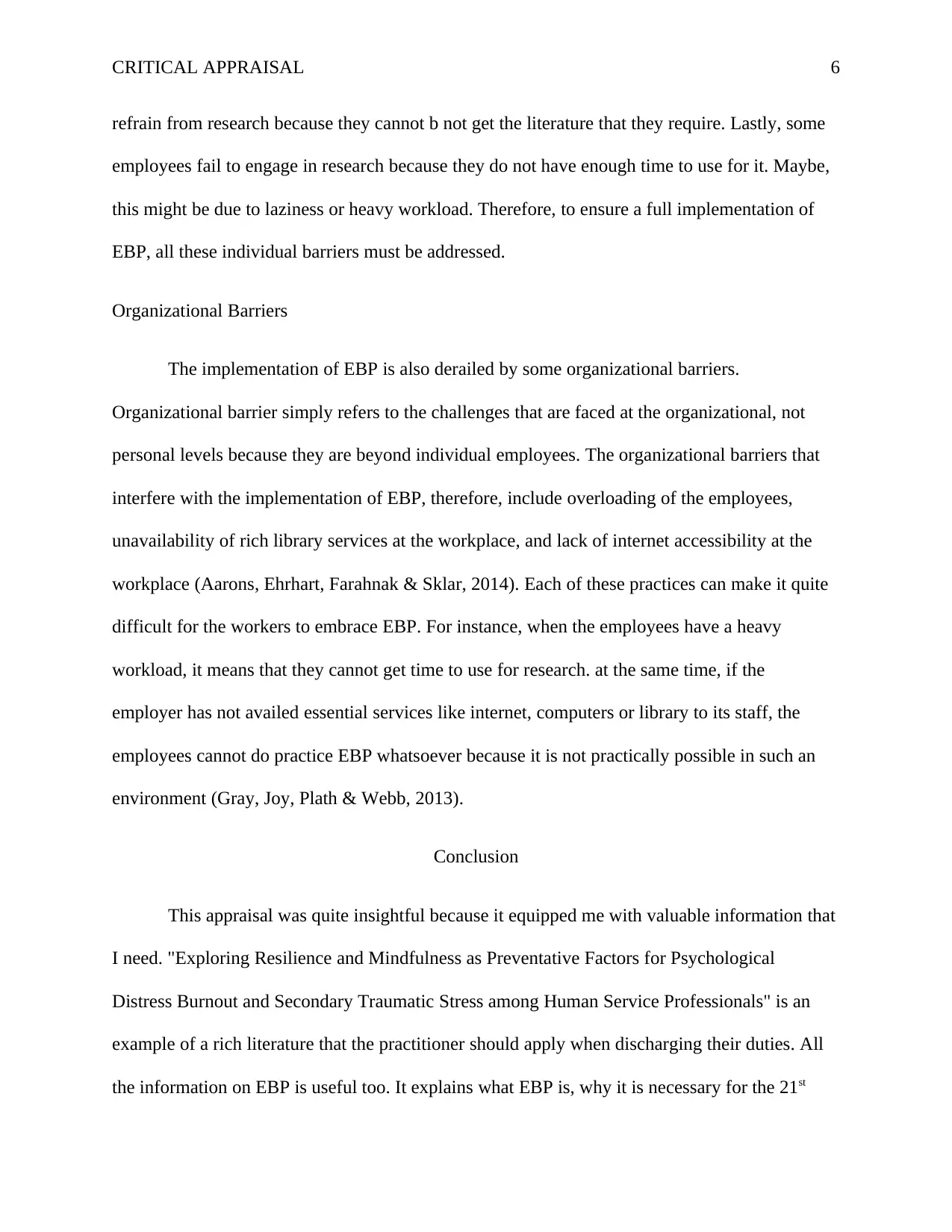
CRITICAL APPRAISAL 6
refrain from research because they cannot b not get the literature that they require. Lastly, some
employees fail to engage in research because they do not have enough time to use for it. Maybe,
this might be due to laziness or heavy workload. Therefore, to ensure a full implementation of
EBP, all these individual barriers must be addressed.
Organizational Barriers
The implementation of EBP is also derailed by some organizational barriers.
Organizational barrier simply refers to the challenges that are faced at the organizational, not
personal levels because they are beyond individual employees. The organizational barriers that
interfere with the implementation of EBP, therefore, include overloading of the employees,
unavailability of rich library services at the workplace, and lack of internet accessibility at the
workplace (Aarons, Ehrhart, Farahnak & Sklar, 2014). Each of these practices can make it quite
difficult for the workers to embrace EBP. For instance, when the employees have a heavy
workload, it means that they cannot get time to use for research. at the same time, if the
employer has not availed essential services like internet, computers or library to its staff, the
employees cannot do practice EBP whatsoever because it is not practically possible in such an
environment (Gray, Joy, Plath & Webb, 2013).
Conclusion
This appraisal was quite insightful because it equipped me with valuable information that
I need. "Exploring Resilience and Mindfulness as Preventative Factors for Psychological
Distress Burnout and Secondary Traumatic Stress among Human Service Professionals" is an
example of a rich literature that the practitioner should apply when discharging their duties. All
the information on EBP is useful too. It explains what EBP is, why it is necessary for the 21st
refrain from research because they cannot b not get the literature that they require. Lastly, some
employees fail to engage in research because they do not have enough time to use for it. Maybe,
this might be due to laziness or heavy workload. Therefore, to ensure a full implementation of
EBP, all these individual barriers must be addressed.
Organizational Barriers
The implementation of EBP is also derailed by some organizational barriers.
Organizational barrier simply refers to the challenges that are faced at the organizational, not
personal levels because they are beyond individual employees. The organizational barriers that
interfere with the implementation of EBP, therefore, include overloading of the employees,
unavailability of rich library services at the workplace, and lack of internet accessibility at the
workplace (Aarons, Ehrhart, Farahnak & Sklar, 2014). Each of these practices can make it quite
difficult for the workers to embrace EBP. For instance, when the employees have a heavy
workload, it means that they cannot get time to use for research. at the same time, if the
employer has not availed essential services like internet, computers or library to its staff, the
employees cannot do practice EBP whatsoever because it is not practically possible in such an
environment (Gray, Joy, Plath & Webb, 2013).
Conclusion
This appraisal was quite insightful because it equipped me with valuable information that
I need. "Exploring Resilience and Mindfulness as Preventative Factors for Psychological
Distress Burnout and Secondary Traumatic Stress among Human Service Professionals" is an
example of a rich literature that the practitioner should apply when discharging their duties. All
the information on EBP is useful too. It explains what EBP is, why it is necessary for the 21st
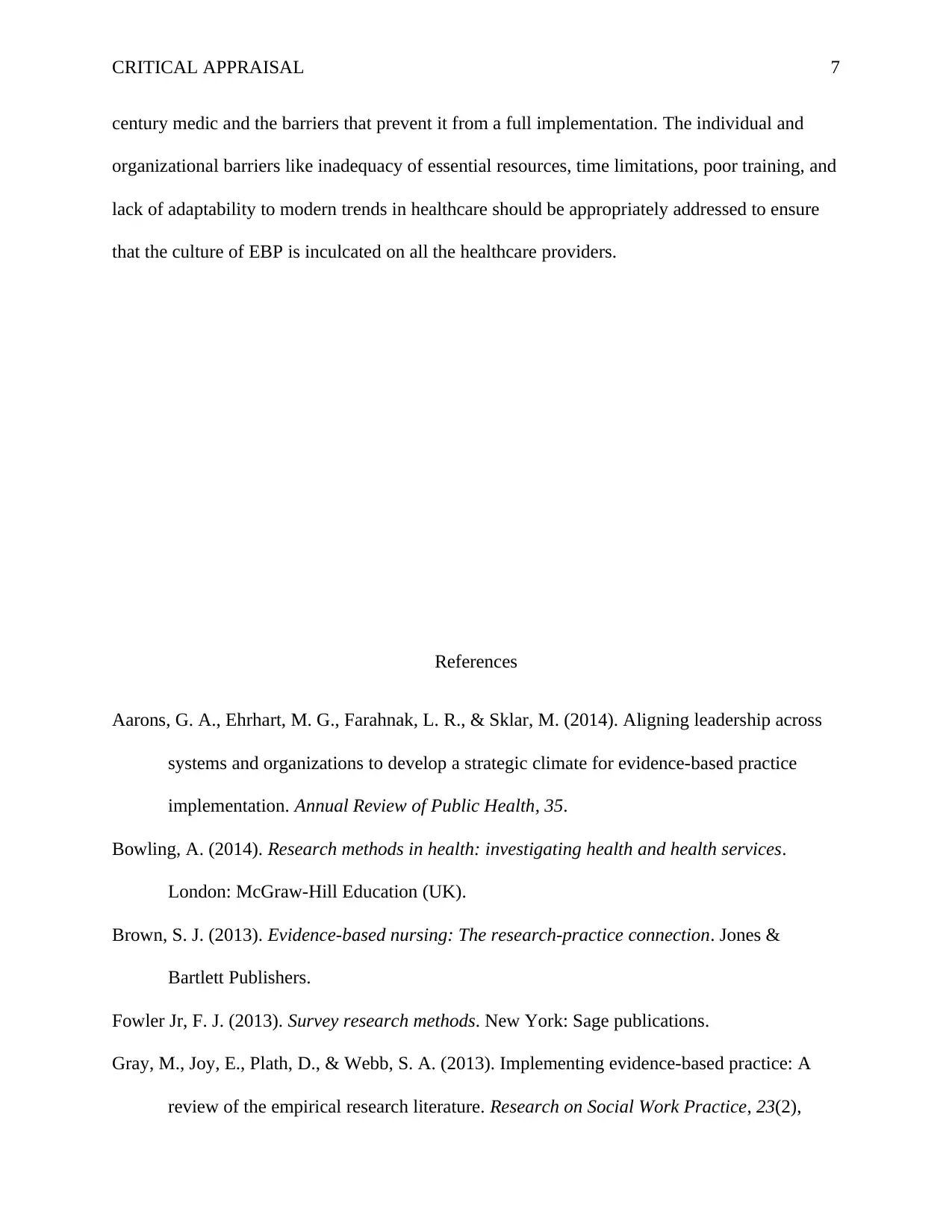
CRITICAL APPRAISAL 7
century medic and the barriers that prevent it from a full implementation. The individual and
organizational barriers like inadequacy of essential resources, time limitations, poor training, and
lack of adaptability to modern trends in healthcare should be appropriately addressed to ensure
that the culture of EBP is inculcated on all the healthcare providers.
References
Aarons, G. A., Ehrhart, M. G., Farahnak, L. R., & Sklar, M. (2014). Aligning leadership across
systems and organizations to develop a strategic climate for evidence-based practice
implementation. Annual Review of Public Health, 35.
Bowling, A. (2014). Research methods in health: investigating health and health services.
London: McGraw-Hill Education (UK).
Brown, S. J. (2013). Evidence-based nursing: The research-practice connection. Jones &
Bartlett Publishers.
Fowler Jr, F. J. (2013). Survey research methods. New York: Sage publications.
Gray, M., Joy, E., Plath, D., & Webb, S. A. (2013). Implementing evidence-based practice: A
review of the empirical research literature. Research on Social Work Practice, 23(2),
century medic and the barriers that prevent it from a full implementation. The individual and
organizational barriers like inadequacy of essential resources, time limitations, poor training, and
lack of adaptability to modern trends in healthcare should be appropriately addressed to ensure
that the culture of EBP is inculcated on all the healthcare providers.
References
Aarons, G. A., Ehrhart, M. G., Farahnak, L. R., & Sklar, M. (2014). Aligning leadership across
systems and organizations to develop a strategic climate for evidence-based practice
implementation. Annual Review of Public Health, 35.
Bowling, A. (2014). Research methods in health: investigating health and health services.
London: McGraw-Hill Education (UK).
Brown, S. J. (2013). Evidence-based nursing: The research-practice connection. Jones &
Bartlett Publishers.
Fowler Jr, F. J. (2013). Survey research methods. New York: Sage publications.
Gray, M., Joy, E., Plath, D., & Webb, S. A. (2013). Implementing evidence-based practice: A
review of the empirical research literature. Research on Social Work Practice, 23(2),
Paraphrase This Document
Need a fresh take? Get an instant paraphrase of this document with our AI Paraphraser
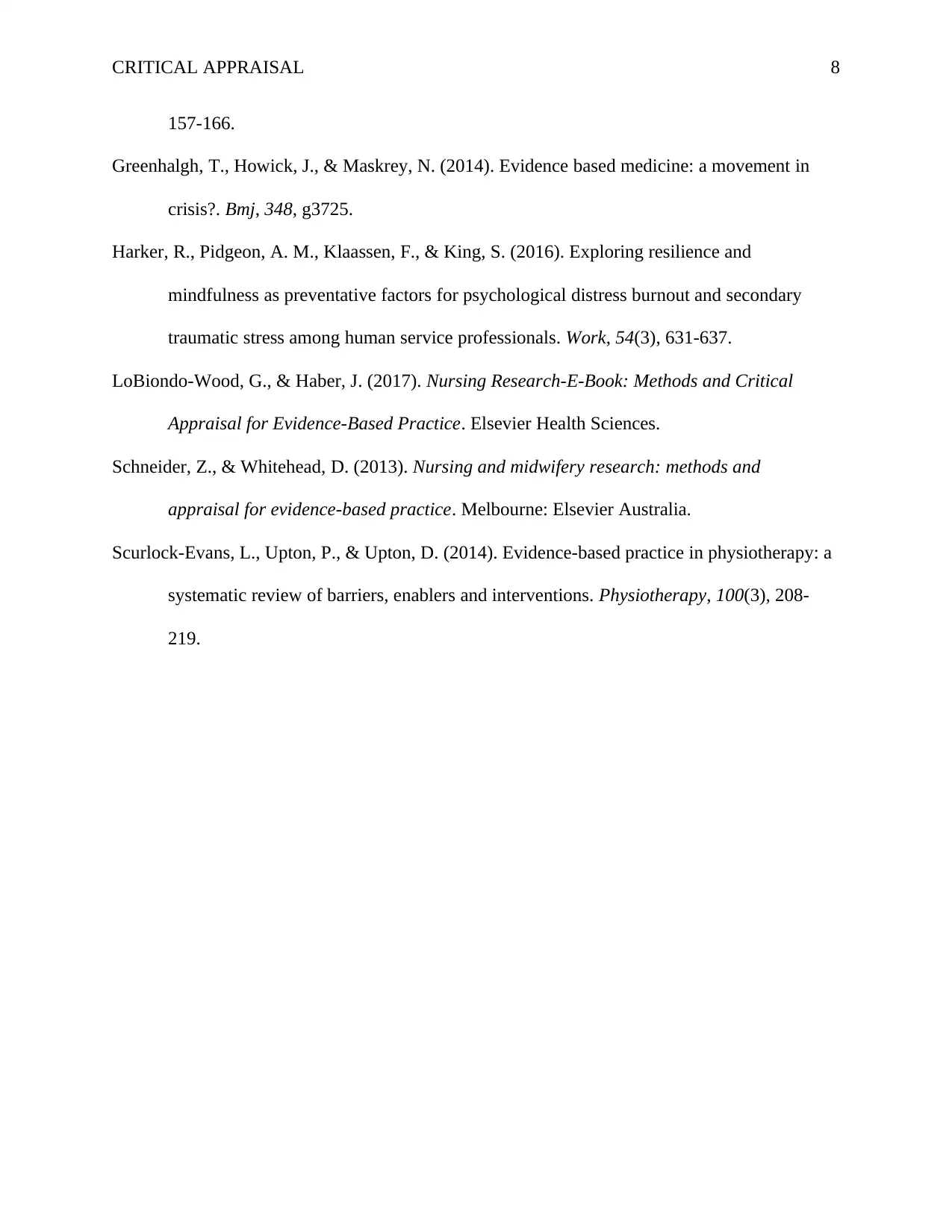
CRITICAL APPRAISAL 8
157-166.
Greenhalgh, T., Howick, J., & Maskrey, N. (2014). Evidence based medicine: a movement in
crisis?. Bmj, 348, g3725.
Harker, R., Pidgeon, A. M., Klaassen, F., & King, S. (2016). Exploring resilience and
mindfulness as preventative factors for psychological distress burnout and secondary
traumatic stress among human service professionals. Work, 54(3), 631-637.
LoBiondo-Wood, G., & Haber, J. (2017). Nursing Research-E-Book: Methods and Critical
Appraisal for Evidence-Based Practice. Elsevier Health Sciences.
Schneider, Z., & Whitehead, D. (2013). Nursing and midwifery research: methods and
appraisal for evidence-based practice. Melbourne: Elsevier Australia.
Scurlock-Evans, L., Upton, P., & Upton, D. (2014). Evidence-based practice in physiotherapy: a
systematic review of barriers, enablers and interventions. Physiotherapy, 100(3), 208-
219.
157-166.
Greenhalgh, T., Howick, J., & Maskrey, N. (2014). Evidence based medicine: a movement in
crisis?. Bmj, 348, g3725.
Harker, R., Pidgeon, A. M., Klaassen, F., & King, S. (2016). Exploring resilience and
mindfulness as preventative factors for psychological distress burnout and secondary
traumatic stress among human service professionals. Work, 54(3), 631-637.
LoBiondo-Wood, G., & Haber, J. (2017). Nursing Research-E-Book: Methods and Critical
Appraisal for Evidence-Based Practice. Elsevier Health Sciences.
Schneider, Z., & Whitehead, D. (2013). Nursing and midwifery research: methods and
appraisal for evidence-based practice. Melbourne: Elsevier Australia.
Scurlock-Evans, L., Upton, P., & Upton, D. (2014). Evidence-based practice in physiotherapy: a
systematic review of barriers, enablers and interventions. Physiotherapy, 100(3), 208-
219.
1 out of 8
Related Documents
Your All-in-One AI-Powered Toolkit for Academic Success.
+13062052269
info@desklib.com
Available 24*7 on WhatsApp / Email
![[object Object]](/_next/static/media/star-bottom.7253800d.svg)
Unlock your academic potential
© 2024 | Zucol Services PVT LTD | All rights reserved.





